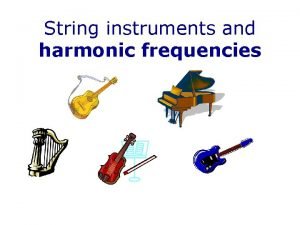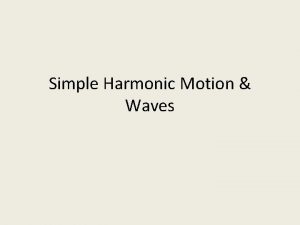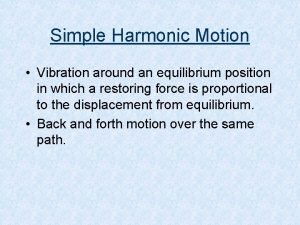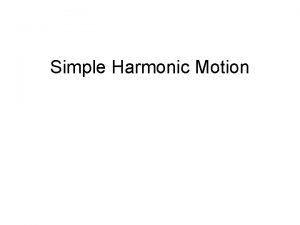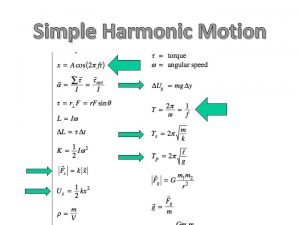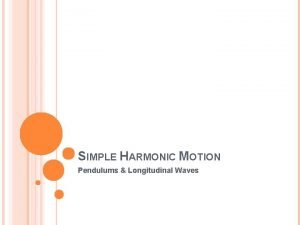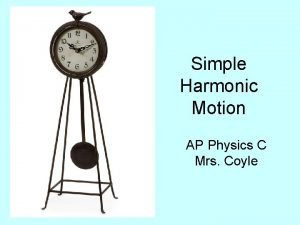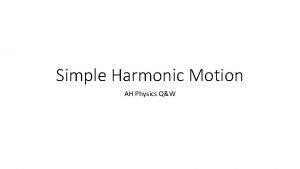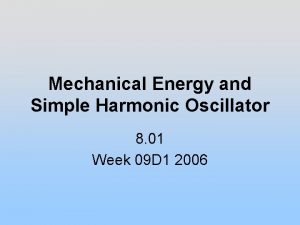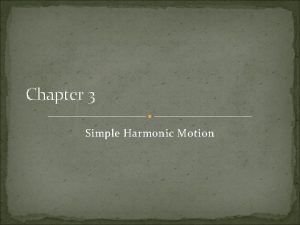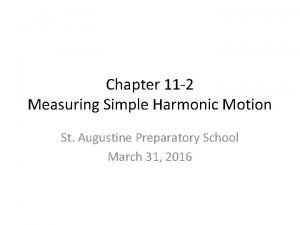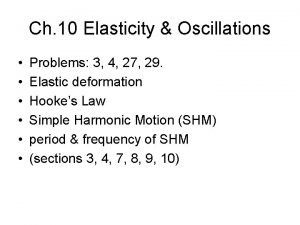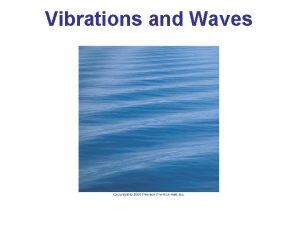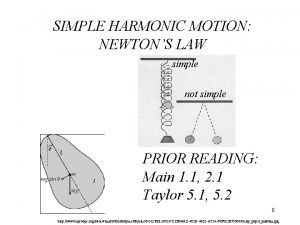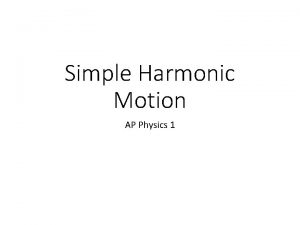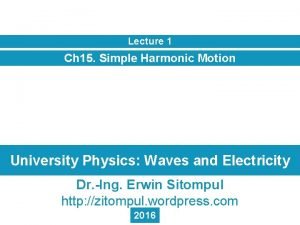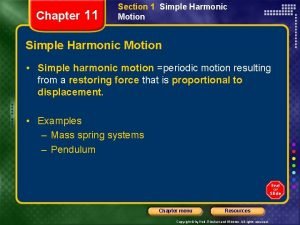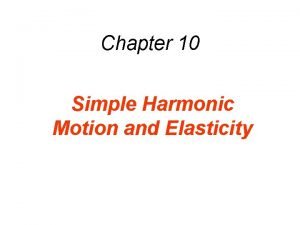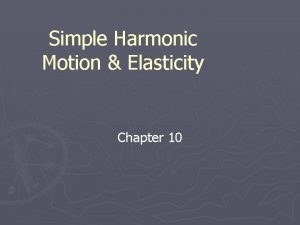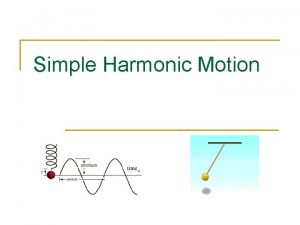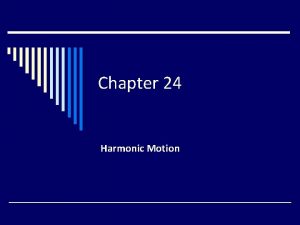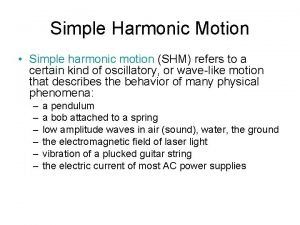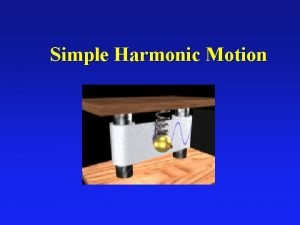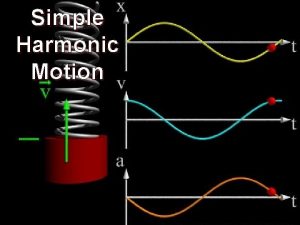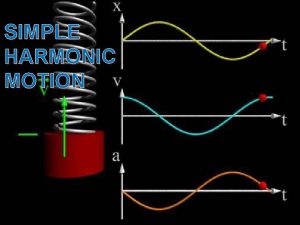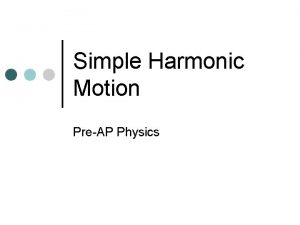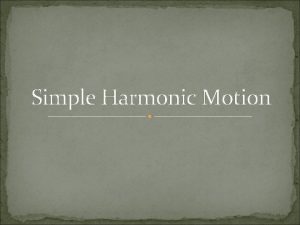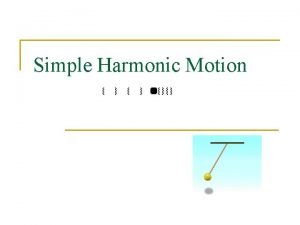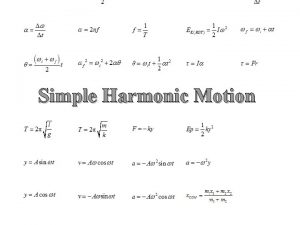Ch 15 Oscillation Simple Harmonic Motion 15 2





















- Slides: 21

Ch 15 Oscillation • Simple Harmonic Motion (§ 15 -2~ § 15 -4) – phase & phase constant – angular frequency ω – velocity & acceleration of SHM – Force law for SHM (§ 15 -3) – Energy in SHM (§ 15 -4) • 微分方程式和它的解 • Springs & Pendulums (§ 15 -6, § 15 -5) – 水平彈簧、垂直彈簧;單擺、複擺、扭擺 • Simple Harmonic Motion and Uniform Circular Motion(§ 15 -7) • Damped SHM (§ 15 -8) • Forced Oscillations and Resonance (§ 15 -9)

Simple Harmonic Motion Hooke’s law 外力跟伸長量成正比 負的? F = -kx Fig. 15 -5 A linear simple harmonic oscillator. The surface is frictionless. Like the particle of Fig. 15 -1, the block moves in simple harmonic motion once it has been either pulled or pushed away from the x=0 position and released. Its displacement is then given by Eq. 15 -3. 『彈簧』的英文怎麼說? Spring displacement 原點在 哪裡? Force: A function of x 什麼力?

Simple Harmonic Motion F = -kx

Simple Harmonic Motion 用 sin 可以嗎? 那 tan 呢? • phase 相位 • phase constant • angular frequency ω

Fig. 15 -3 紅波和藍波有什麼不同? Amplitude Period Phase


Force law for SHM (§ 15 -3) • Hooke’s law F = - k x • Newton’s 2 nd law F = ma • S. H. M. a = -ω2 x (15 -8) (15 -11) • (15 -12) (15 -13) Check point 2: • 只要力的形式是 F = - k x,就是 SHM (Why? ) • See Problem-solving Tactics 2 (p 392)

Sample Problem 15 -1 A block whose mass m is 680 g is fastened to a spring whose spring constant k is 65 N/m. The block is pulled a distance x = 11 cm from its equilibrium position at x = 0 on a frictionless surface and released from rest at t = 0. (a) What are the angular frequency, the frequency, and the period of the resulting motion? (b) What is the amplitude of the oscillation? (c) What is the maximum speed vm of the oscillating block, and where is the block when it occurs? (d) What is the magnitude am of the maximum acceleration of the block? (e) What is the phase constant ψ for the motion? (f) What is the displacement function x(t) for the spring–block system?

Sample Problem 15 -2 At t = 0, the displacement x(0) of the block in a linear oscillator like that of Fig. 15 -5 is -8. 50 cm. (Read x(0) as “x at time zero. ”) The block's velocity v(0) then is -0. 920 m/s, and its acceleration a(0) is +47. 0 m/s 2. (a) What is the angular frequency w of this system? (b) What are the phase constant ψ and amplitude xm? initial conditions (初始條件) x(0)= - 8. 5 cm v(0)= - 0. 920 m/s a(0)=47 m/s 2

Sample Problem 15 -2 已知 initial conditions(初始條件) 即 t =0 時, x(0)= - 8. 5 cm v(0)= - 0. 920 m/s a(0)=47 m/s 2 求 (a) ω=? (b)φ=? , xm=? 有一個解不合,why? Homework Ch 15, Problem 9, 10, 17, 87

Homework Question 2 Question 4 Ch 15, Question 1, 2, 4, 5, 8, 9 Question 5 Question 9 Question 8

Ch 15, Question 2 (a-t 圖) The acceleration a(t) of a particle undergoing SHM is graphed in Fig. 15 -19. (a) Which of the labeled points corresponds to the particle at -xm? (b) At point 4, is the velocity of the particle positive, negative, or zero? (c) At point 5, is the particle at -xm, at +xm, at 0, between -xm and 0, or between 0 and +xm?

Ch 15, Question 4 ( v-t 圖) The velocity v(t) of a particle undergoing SHM is graphed in Fig. 15 -20 b. Is the particle momentarily stationary, headed toward -xm, or headed toward +xm at (a) point A on the graph and (b) point B? Is the particle at -xm, at +xm, at 0, between -xm and 0, or between 0 and +xm when its velocity is represented by (c) point A and (d) point B? Is the speed of the particle increasing or decreasing at (e) point A and (f) point B?

Ch 15, Question 5 ( x-t 圖) Figure 15 -21 gives, for three situations, the displacements x(t) of a pair of simple harmonic oscillators (A and B) that are identical except for phase. For each pair, what phase shift (in radians and in degrees) is needed to shift the curve for A to coincide with the curve for B? Of the many possible answers, choose the shift with the smallest absolute magnitude.



Energy in SHM (§ 15 -4)

Energy in SHM (§ 15 -4) • 位能 • 動能 • 機械能 E = 動能+位能 Fig. 15 -6(b) Potential energy U(x), kinetic energy K(x), and mechanical energy E as functions of position x for a linear harmonic oscillator with amplitude xm. For x=0 the energy is all kinetic, and for x=xm it is all potential.



Energy in SHM (§ 15 -4) Question 9 Homework: Question 9 Problem 30, 31, 32, 35
 Simple harmonic motion formula sheet
Simple harmonic motion formula sheet Wave
Wave Simple harmonic motion vocabulary
Simple harmonic motion vocabulary Equilibrium position of a wave
Equilibrium position of a wave Spring constant simple harmonic motion
Spring constant simple harmonic motion Reference circle simple harmonic motion
Reference circle simple harmonic motion Simple harmonic motion formula
Simple harmonic motion formula Simple harmonic motion formula
Simple harmonic motion formula Harmoninic ah
Harmoninic ah Dimension of simple harmonic motion
Dimension of simple harmonic motion Simple harmonic motion formula
Simple harmonic motion formula Simple harmonic motion
Simple harmonic motion Measuring simple harmonic motion
Measuring simple harmonic motion Frequency of shm
Frequency of shm Simple harmonic motion formula
Simple harmonic motion formula Energy of simple pendulum
Energy of simple pendulum Simple harmonic motion ap physics 1
Simple harmonic motion ap physics 1 Simple harmonic motion presentation
Simple harmonic motion presentation Slidetodoc
Slidetodoc Simple harmonic motion chapter 11
Simple harmonic motion chapter 11 Simple harmonic motion and elasticity
Simple harmonic motion and elasticity Simple harmonic motion and elasticity
Simple harmonic motion and elasticity

